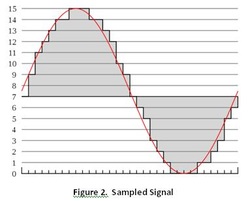Analog Oscillators

Voltage Controlled Oscillators (commonly referred to as VCOs) are used in synthesizers to convert a DC signal from the power supply into an AC signal, where the signal then oscillates at a certain frequency, generating a sound. The frequency of a VCO can be adjusted via input voltage or current modulation. Many synthesizers have more than one oscillator. To prevent phasing issues in the output signal, these oscillators are used in phase-locked loops, where the frequency of one oscillator is locked to the frequency of another. In an Resistor Capacitor oscillator circuit, higher input voltages increase the rate of charge in the capacitor plates, decreasing the time needed for one full oscillation. Feedback loops are made by routing the output signal back into the input of the amplifier, typically resulting in analog distortion favored by synthesizer enthusiasts. RC oscillator circuits are capable of generating frequencies within the range of human hearing, and thus are widely used. Signal shapes such as triangle, sine, and square waves are generating depending on the different types of transistors, operational amplifiers, resistors, and capacitors used in the oscillator circuit. VCOs are naturally unstable and imprecise. Although VCOs cannot be precisely tuned, they are favored for sounding "warmer" and more "natural" than digital oscillators.
Digital Oscillators

Digital oscillators are electronic oscillating signals generated by digital signal processing. DSP uses mathematical modeling of an input signal to generate an ideal waveform without errors. The information for an analog waveform is sampled to represent a stream of 1's and 0's. An issue with lower-quality digital oscillators is that the resulting sampled waveform can result in a stepping pattern, unlike the smooth nature of an analog signal. This is why digitally converted sound files such as a .mp3 sound worse at lower sampling rates. The original analog signal has been sampled at a rate that is much lower per second, resulting in audible stepping in the sampled waveform. However, higher quality synthesizers have much higher sampling rates. This results in a smooth, precise waveform that can behave as predictably, of unpredictably as desired, depending on the amount of mathematical modeling involved. The freedom of mathematically modeling a sampled waveform opens up many more opportunities to the manufacturer in terms of sound generation. Digital oscillators are much more reliable than VCOs, because the oscillators are not generated by physical components, where physical components can often break down over time. Many enthusiasts feel that digital oscillators will never be able to truly emulate an analog signal.